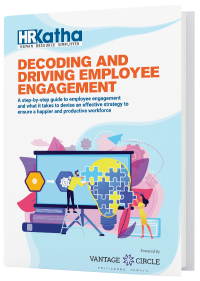7 Employee Engagement Strategies That Will Not Fail

If you do not have well developed and clearly defined employee engagement strategies, it does not show positive outcomes.
Poor employee engagement is a serious concern, and many employers are failing to resolve this problem.
An organization’s success is directly proportional to its employees’ happiness, and how engaged they are in their work.
Money is not the only driving factor for employees these days. It is the overall experience they have in the workplace. Employee engagement will follow when you create the right work environment to help your employees in their career development and have open communication in the workplace.
So how do you balance these factors and create an environment which works best for your employees?
This is when you need to plan the right employee engagement strategies.
According to Gallup research, only 13% of employees are engaged in their workplace worldwide. It is not that these companies are not aware of employee engagement or do not take efforts to improve employee engagement.
The problem is that often these employee engagement strategies are not well thought out and not well executed. Remember, it is for your employees and how you make their work-life satisfactory. As I have already mentioned, money is not the only factor; sometimes, a ‘Thank You’ can do wonders.
Mindless Employee Engagement Strategies, Which Are Failing You!
This may sound a little harsh to you, but believe me, you would thank me later.
The Shallow Approach: If you give your employees a hike only to boost their morale or make them engaged, then you might want to reconsider or give thought to it.
A hike would help your employees and make them happy for some time but won’t help your retention rates or engagement in the long run.
This is what I meant by a shallow approach. Employee engagement is not a trend or tactic to follow. This is a deliberate and consistent effort to empower, motivate, and engage your workforce and align them with your goals and objectives.
Inconsistent Approach: Do not make the whole process a shallow one-time affair. If you are not consistent in your efforts, it will do more harm than good.
Not Knowing What Your Employees Want: Often, organizations, follow the rat race and conduct employee engagement programs for its sake and fall flat on their faces.
Employee engagement is the workplace approach for all the workplace members and creates an environment that suits all and helps each and everyone give their best.
So if you are planning to design the right employee engagement strategies, then make one that suits your company’s culture and its members.
If you take care of the employees’ needs and build strategies around those aspects, you would create an engaged workforce and enhance the overall employee experience.
Read more: 5 Horrific Employee Engagement Strategies To Avoid
Here are the 7 Employee Engagement Strategies That Won’t Fail
1. Employee Engagement Survey
Think “Bottom-Up,” not “Top Down.” While planning a business strategy for employee engagement, you must know what your employees want and what matters to them. It is not about top authorities and human resources brainstorming and strategizing for them without knowing their perspectives.
This is why conducting employee surveys is a must. Ask them questions (Prepare an online survey or questionnaire) know what they want and how they feel working. Or if anything that is bothering them and areas they think the organization should look into.
This data would help you understand your employees and their needs and reveal many undiscovered insights to you.
Remember, every company culture is different, so set the questionnaires that best suit your organization.
Once you examine the employee survey data, you are good to start your employee engagement strategies. For example, if the data reveals that the managers or peers are not appreciated enough, plan an appreciation and recognition program, be consistent in your efforts, and find ways to solve this issue.
Remember! If your efforts are half-hearted, it won’t show any positive results. Don’t do it for the sake of it but do it because you care for your employees.
Related: A Brief Guide On Employee Pulse Surveys
2. Strong Communication
How is your internal communication? Or how is the communication between the managers and the employees?
Open communication between the members of the organization is vital. It helps employees open up and discuss ideas or problems they face and builds trust.
Employees are the building blocks of your organization, and you must keep them updated and include them in every small/big discussion.
For a more engaged workforce, there must be effective communication to keep the ball rolling. For that to happen, you must implement:
- The right internal communication strategy.
- A consistent two-way communication.
- Bring more transparency.
Related: 7 Reasons Why Internal Communication is Important in the Workplace
3. The Power of Reward and Recognition
Rewarding and recognizing your employees for their efforts is one of the best strategies.
Rewarding and recognizing does not necessarily have to be monetary. Like I said before, a ‘Thank You’ often can do wonders. It's more about how much care for your employees.
Celebrating birthdays, anniversaries, written notes, or rewards through an online platform is one of the best ways to recognize your employees’ hard work.
When employees are rewarded and recognized for their work, it builds employee morale, productivity, and overall employee satisfaction or job satisfaction.
Related: 50 Rewards and Recognition Ideas to Boost Employee Recognition
4. Take Care of Their Well-being
Psychological well-being consists of-
- Positive relationships with others.
- Personal Mastery.
- Freedom.
- A purpose in life.
- And personal growth and development.
When you want to take care of your employees, make sure you don’t miss out on any aspects mentioned above.
This would show the employees that you care for them and their wellbeing. It's inherent in human psychology that we tend to be more comfortable and at our best when these aspects of wellbeing are taken care of. That is why we are more comfortable and happier when we are around our loved ones or at our homes.
Employers who understand this aspect well and try to give their employees a wholesome working experience build a more happy and engaged workplace.
Here is what you can do.
- Actively listen to your employees.
- Help them out in need, and always give your support.
- Go and sip a cup of coffee together and try to know them personally.
5. Respect, Trust, and Value Them
William Kahn, the father of Employee Engagement, found out that for an employee to feel engaged, they had to be respected, trusted, and valued.
When you respect, trust, and value your employees' work and effort, you create an environment full of positivity and enthusiasm. It helps teams members to:
- Have a great rapport with each other.
- Discuss ideas and have open conversations.
- Build trust and work relationships.
- Builds a collaborative workforce and thrive together.
Related: 6 Practices To Ensure Trust In The Workplace With Employee Engagement Initiatives
6. Acknowledge Their Contribution
Acknowledge your employees' contributions openly. Create a culture where each and every member of the organization acknowledges each other's good work. Give open feedbacks to boost their morale.
Let's imagine this together! You have been assigned a project. You are excited and worked extra hard to complete it. You submit your work to your immediate team manager. But he did not even thank you. Not even a single member of your team gave any heed to your project, which you are really proud of.
How would you feel? Would you now be equally excited about the next project?
You know the answer better.
So acknowledge your employees and create a culture that is empowered.
7. Ask Their Opinions
Before starting a new project or solving any issues in the workplace, ask for your employees’ opinions. This would give the employees a feeling of importance and that their views and opinions matter. It also makes employees believe that their work makes a difference, and they put more effort into working towards the organization’s goals and objectives.
These opinions or views also help employers to make an informed and collective decision.
Conclusion
Keep in mind that your efforts to keep your employees happy and engaged need efforts and consistency. It may not show results immediately. But if you genuinely invest your time and put effort, you would soon create a workforce that will thrive.

Vantage Circle is a simple AI-powered Rewards & Recognition Platform for upgrading your employee experience and engagement for better productivity.






